There is a well-defined set of rules for writing letters and emails. These messages have a clear structure and their exchange follows a logical pattern.
But is there a similar set of best practices for writing with people on live chat?
Is it OK to proactively engage customers and write the first message? As a chat agent, should you introduce yourself or is it better to answer the question right away? Are there any rules at all?
While nothing is really set in stone when it comes to live chat etiquette, there certainly are some great rules of thumb.
Try out the best free live chat software on the market and improve your support
Chat etiquette is essential for successful live chat support. But, just to make things clear, here is a short definition:
What is live chat etiquette?
Live chat etiquette is a set of good practices for chat operators. It helps to maintain the positive tone of the interaction and resolve issues in a professional manner. Observing chat etiquette increases customer satisfaction—it can be an important part of the overall customer experience that your business creates.
So—
How to make a great impression on your customers and deliver superb support experiences?
Let’s find out how to carry out a professional live chat conversation from start to finish. Below are the most important chatting rules.
What do you say in a live chat?
Live chat responses are not that much different from regular phone calls. The standard reply would simply be something along the lines of: Hello, thank you for messaging our support team. How may I help you?
1. Keep your response times short
You shouldn’t keep your customers waiting on hold. After all, what is the use of mastering live chat etiquette if you miss your customers altogether? It is critical that customer service agents respond f-a-s-t!
Instant messaging is called “instant” for two reasons:
- Messages are delivered instantly
- The exchange of messages is dynamic and happens in real-time
Live chat sessions are meant to be live. According to our customer experience study, almost 50% of customers believe that the average chat service response time should be under 5 minutes.
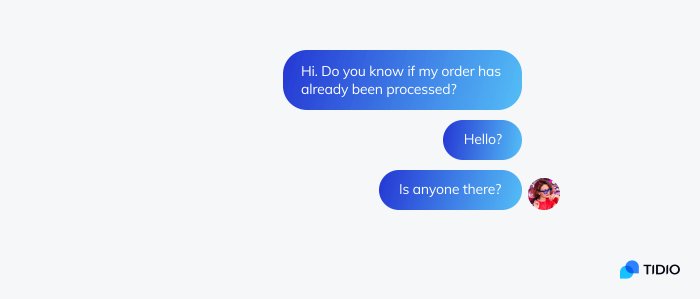
Customers are extremely impatient. But you won’t miss incoming messages and they will be less likely to leave if you use:
- Automatic welcome messages and greeting for customers
- Chat requests appearing as push notifications on your mobile (or Slack)
- Integration with social media and WhatsApp
- Chatbots that stall for time and engage customers
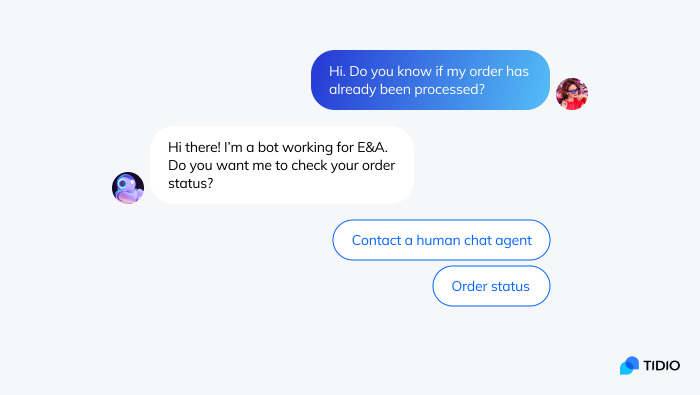
Make sure that your live chat widget has those functionalities. They significantly improve response times and the quality of customer support.
Watch out for:
- Overusing quick responses. Automatic messages are a cool feature but everything is good in moderation. If you bombard the customer with a whole sequence of long messages it may discourage them from continuing the conversation.
- Assuming it is too late to respond. If you got delayed and someone wrote you a message half an hour ago, it doesn’t mean that you shouldn’t write back. It is very likely that there is still a live chat button open in one of the tabs of the client browser.
Read more: What Is the Best Live Chat Software?
2. Start with a friendly greeting
A typical live chat experience is much more straightforward and convenient than traditional phone calls or emails. It is one of the most effective communication channels.
As an agent you don’t have to introduce yourself, because users can already see your avatar and your name. And you don’t need to be extremely uptight or use very formal greetings, such as business email salutations.
The simplest greetings will be perfectly OK.
Stick to:
- Hi!
- Hello!
- Hi [name]
- Hi there
You can also mirror what your customers write to you. Just don’t overdo it. When someone writes “yo dawg!” you should still reply with “hi.”
If they send only their greeting, reply and offer assistance.

There is no need for:
- Good day to you. My name is Josh and I’m going to be your customer service agent. How can I be of service to you?
It is too long, formal, and filled with unnecessary information.
If they omit the greeting and get straight to the point, pretend that the “hi” is implied. But yours should be explicit. Always write “hi” or “hello,” even when your visitors forget about it.
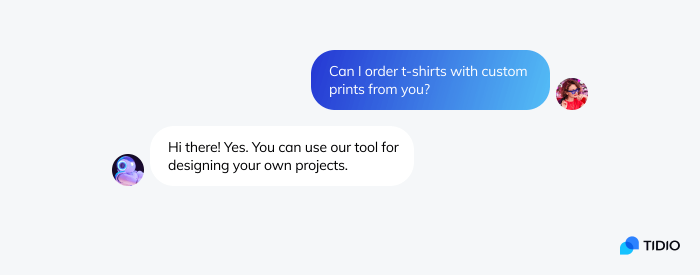
If as an agent, you are the one who initiates conversations proactively, so you can make the first messages slightly longer. Try to state your business and introduce yourself, but keep it short and sweet. After all, it is not an email.
Read more: Reactive vs Proactive Customer Service: The Ultimate Guide
3. Add a personal touch
Marketers claim that personalized experiences increase sales by 20%. And you can leverage the power of personalization in many easy ways. For example, using your customer’s name is great for building customer relationships.
A study involving five bank companies has shown that using customers’ names by employees and support agents increased customer loyalty and satisfaction levels. Customers who were addressed by their first names were 30% more likely to recommend the bank to their friends.
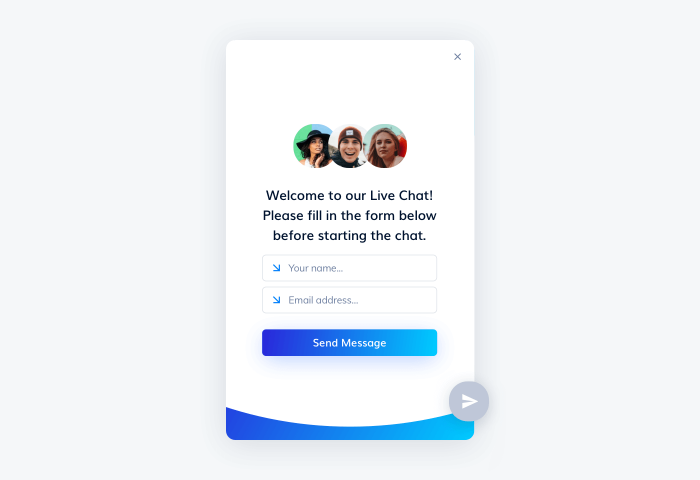
Asking customers what their names are during a conversation with your support team might come off as awkward and out of context. But you don’t have to do it manually. There is no need to ask directly when you can use a form, which makes the request completely natural.
Read more: Relationship Marketing Examples & Best Tools
4. Listen to the person on the other end
Knowing that a company’s representative listens to our problems is the most fundamental of customer needs. As an agent, you can show that you listen actively by asking follow-up questions and rephrasing what’s been said.
You should accept the “reality” of the situation as described by the customer. Avoid enforcing your point of view, try being empathetic instead.
Watch out for:
- Interrupting. If someone is writing a longer sequence of messages, you can disrupt the flow of the conversation by addressing only the things mentioned in the beginning. Use live typing preview (it is one of the features available in Tidio) to see messages even before they are sent.
5. Adjust the tone of your messages
Professional chat etiquette requires matching the tone of your messages with what your customers expect to read. Inappropriate tone draws too much attention to the form of your message instead of its meaning.
For instance, as a support agent you may not know answers to all questions a customer asks you, which isn’t the most comfortable situation for either of you. But the way you admit it can be crucial to the way your interaction ends. So, if you choose to type a shrug emoji, you can expect your interaction to serve as an example of bad customer service.

The best rule of thumb is to be friendly, polite, and positive. But refrain from trying to be funny or cutesy. It may be interpreted as being condescending. You should be very careful especially while dealing with angry customers.
Watch out for:
- Being too informal. Sending GIFs or emojis can backfire. If you are handling a problem, your customer may not be in the mood for funny cats or smiley faces.
- Abbreviations. Not everyone is well versed in typical chat jargon. It is better to write “I’ll be right back with you” instead of “brb.”
- Using technical jargon. Your website visitors don’t have to be experts—it is good to keep things simple and explain everything in plain English.
6. Demonstrate empathy and understanding
Look at any issue at hand from your customers’ perspective. It is possible that they have been attempting to address the issue for some time before contacting you. Maybe they are in a hurry to deal with the issue because of a deadline. There are all sorts of common customer service scenarios that a good live chat agent should be aware of.
Reaching out to an agent may be the last thing they do in an act of desperation. You are their last resort, and you have to help them.
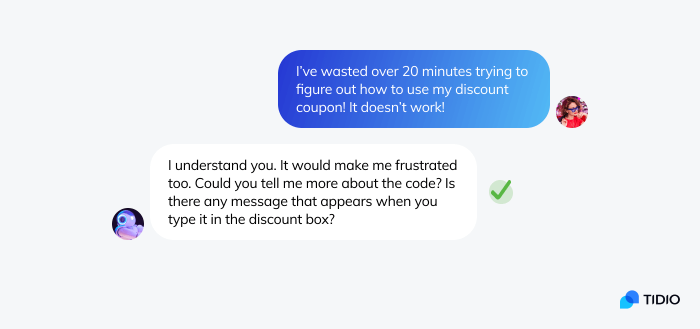
Never reply in the following manner:
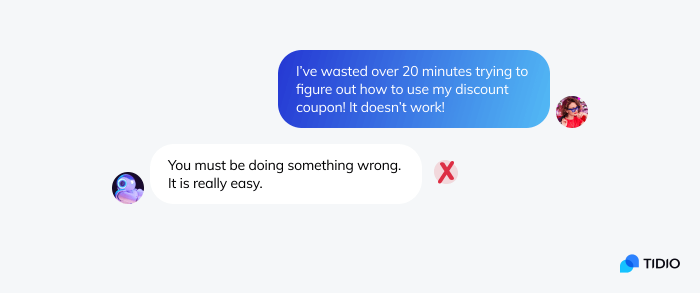
Some customers don’t expect you to solve the problem at all because maybe it can’t be solved. They simply expect you to listen and understand them. That alone can make them feel better.
Watch out for:
- Your opinions. Don’t be judgemental or tell people to calm down. You are in no position to express your opinions when you are not asked about them.
- Being patronizing towards your customers. There are many types of customers and some of them may be very sensitive. You’ll learn how to keep your empathy levels well-balanced as you get experience.
- Forcing people to repeat themselves. The least empathetic thing you can do to a customer is to bounce them from one agent to another and force them to explain the problem to everyone over again. It is better to use a group chat feature and let other agents read the whole conversation from the beginning.
7. Know when and how to apologize
“Sorry,” “thank you,” and “please” are some of the simplest and most powerful phrases that you can use when handling customers. They cost you nothing and make conversations much easier and smoother. Most of the time, customers will try to contact you when things go wrong or when they don’t understand something.
Offering apologies or sympathy won’t hurt you, even if it isn’t always necessary. But “we are sorry to hear that” combined with offering a solution (or at least a consolation) sounds a million times better than pointing out that the customer made a mistake.
Sometimes you may be tempted to get into a discussion. If the customer is wrong, you should by all means correct them. But remember that at the end of the day, it is always “your” fault. If customers can’t figure something out, maybe your instructions should be clearer, or you should create additional resources to help your customers?
Watch out for:
- Pointless arguments. Customers are always right. If they are wrong, you should acknowledge that they had every reason to think something was true and move forward.
Read more: How to Write an Apology Letter to a Customer
8. Focus on your customer’s problem
Staying on topic is the foundation of efficient customer service. A friendly chit-chat is fine if it matches the caller’s communication style. But let’s consider a situation like the exchange of messages below:
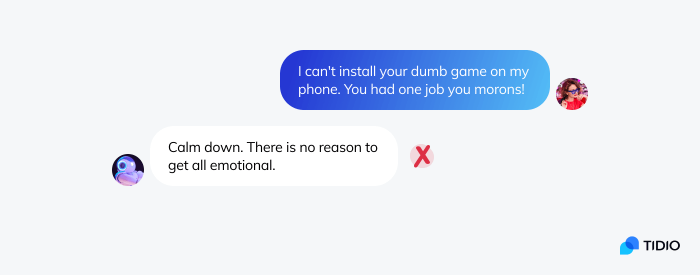
Messages of this type are not particularly helpful. Instead of moving the conversation forward to a resolution, they open the ground to a completely new debate. What if the customer believes that they have every reason to get emotional?
It is better to ignore swearing and being called names. It happens and it is only the matter of delivery.
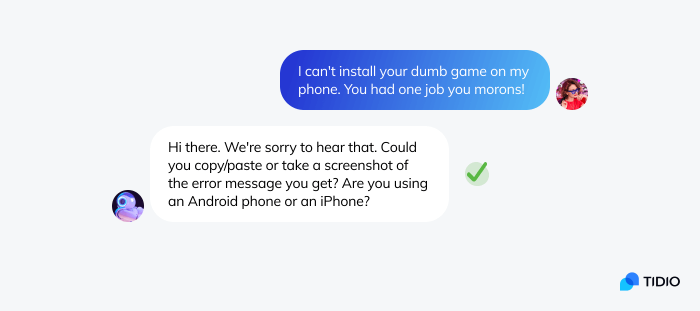
The problem has already been voiced at this point and we should focus on asking follow-up questions that bring us closer to a solution.
Watch out for:
- Getting provoked or sidetracked. Customers may ask additional questions that are completely unrelated to the problem at hand. It is perfectly OK to say “We’ll come back to that later. For now, please let’s solve X first.”
Read more: Good Customer Service Examples to Inspire Your Team
9. Stay positive throughout all chat interactions
You may think that a customer who complains is a lost customer. It probably isn’t worth paying attention to them because they won’t buy anything from us again anyway, right?
Many studies show that the correlation between customer complaints and reduced customer loyalty is surprisingly weak. By no means does this mean that you should neglect it. But negative experiences have three times less impact on loyalty than positive experiences.
Most customers are actually willing to cooperate if given the chance. Softening the way you deliver information is also important. You can try to eliminate phrases such as “don’t,” “you should have” and “yes, but.” They are examples of negative language and they fuel conflict.
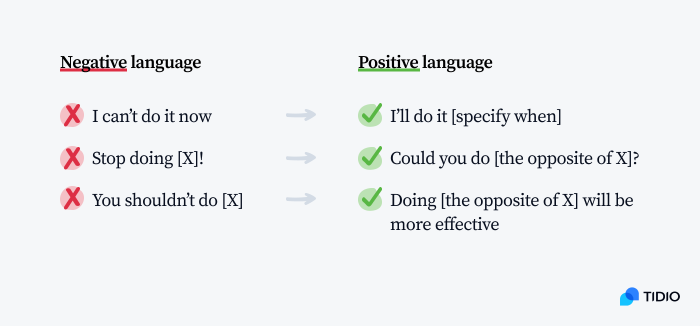
Using positive language on the internet makes your posts and messages almost 20% more trustworthy. The positive tone of your live chat messages will improve their clarity and make you seem more cooperative.
Many experiments reveal that just by switching the vocabulary that we use to describe our reality, we change our attitude. If you half-mockingly start calling the bosses you don’t like “perfectionists,” they start to seem like nice guys.
Read More: How to Use Positive Language
10. Make sure that the all problems have been resolved
Sometimes live chat conversations are a bit chaotic and asynchronous. Customers go to the kitchen to make themselves a sandwich and then forget that they talked to the operator at all. It is normal that they suddenly write back after a few hours. That’s why it is not uncommon that typical chat conversation examples would span over hours.
Treat every request as open until the customer thanks you. Then make sure their issue is resolved.
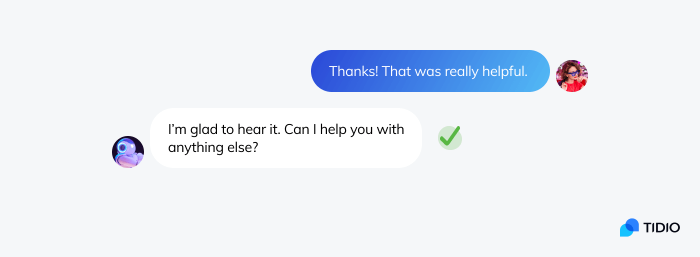
According to the common rules of chat etiquette for customer service, the conversations end when customers explicitly tell you that they don’t need anything more.
Watch out for:
- Closing the conversation too soon. It is the customer and not you who should signal when your chat interaction is over.
11. Collect feedback from customers
When it is clear that the conversation is over, sending a customer satisfaction survey right after the end of the chat is a great idea. Measuring the quality of your service will help you determine if you are making any progress with your chatting etiquette.
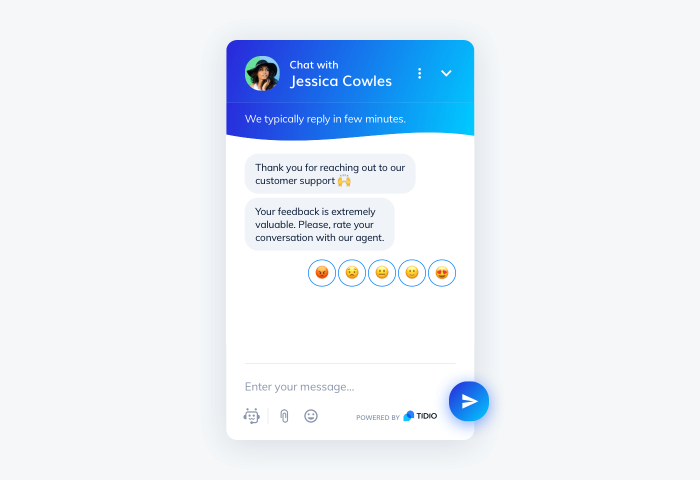
Some companies go a step further. They don’t just collect customer feedback to improve the quality of their service. Every chat with customer support teams is an opportunity. For example, Whisker Bag (a cat travel bag company) uses live chat to encourage customers to leave positive reviews of their store on the internet.
12. Extra: Remember about correct grammar and spelling
Writing with friends on Messenger does not require excessive concern for grammar and correct spelling. It’s rare to see people’s inner Grammar Policeman awaken during casual conversations. Unfortunately, when writing is your profession, you will be judged much more harshly. Even if all you write are live chat messages.
Mistakes do cast a negative light on the business that you represent. That’s why you should:
- Double-check your live chat messages
- Use an automatic grammar checker plugin
- Refresh your knowledge of the most common language mistakes
Read more: What Are the Most Annoying Grammar Mistakes?
Key Takeaway
Contacting support teams via live chat instead of email is slowly becoming the primary option. Customers can get help from agents representing the business almost right away. This is a great convenience and it saves time. Therefore, it makes sense to focus on improving your quality of communication through this channel.
So, what are some essential tips and rules that you should follow and things to avoid?
The core dos and don’t of chat etiquette
Do:
- Reply fast
- Say hi or hello
- Personalize your communication
- Use active listening skills
- Adjust the tone of your writing
- Try to understand the customer
- Apologize when it is necessary
- Stay focused on resolving the case
- Use positive language
- Collect customer feedback
- Make sure to resolve the issue
- Use correct English
Don’t:
- Ignore customers
- Interrupt
- Be judgmental
- Be condescending
- Allow yourself to be provoked
- Be too straightforward
- Argue with the customer
All tips may seem very abstract and theoretical until you put them into practice. That’s why we encourage you to try live chat now to start gaining hands-on experience.
Try out the best free live chat software on the market and improve your support

